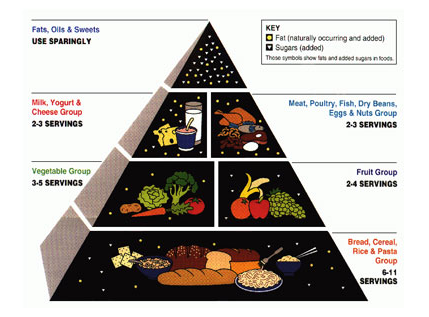Nutrition Advice Gives Me Indigestion

Experts not only disagree in the moment. They disagree with themselves over time. What is determined to be accepted wisdom changes sometimes significantly.
Nowhere is this more evident than in the field charitably called “nutrition science.” The U.S. government has been providing nutritional guidelines for Americans via the Department of Agriculture (USDA) since the 1890s. Let’s look at how their guidelines have changed just in modern times.
From 1956 to 1992, the USDA recommended its “Basic Four” food groups. These consisted of meat, milk, fruits and vegetables, and breads and cereals.

The USDA introduced the food pyramid above in 1992 to illustrate that some foods should be eaten in greater quantities than others. Note bread, rice, and pasta proudly holding up the base of the pyramid.
The most recent dietary guidelines (2020-2025) are back to the descriptive format, with certain food groups being recommended generally. Fair enough. But you could be forgiven for thinking that after 120 years of experience, and over the space of a 164-page guide, our nutritionist experts could be quite specific about what the hell we should eat. Alas, consider this from the executive summary:
An underlying premise of the Dietary Guidelines is that nutritional needs should be met primarily from foods and beverages.
I’m glad they cleared that up. I was planning on eating sawdust tonight and chasing it down with lighter fluid.
To be fair, the guidelines do go on to specify that they mean “nutrient-dense foods and beverages.” Much better.
What is by turns amusing and maddening about nutrition advice are the villains variously fingered as the causes of our ill health. What foods (or nutrients now I guess) must we consume in moderation or avoid? Over the years, this has varied in USDA guidance Dietary Recommendations and How They Have Changed Over Time:
- Fats, sweets, and alcoholic beverages (1970s)
- Fat, saturated fat, cholesterol, and sodium (1980s)
- Fats, oils, and sweets (1990s)
The keen reader will detect that the recommendations are consistent on at least one thing: we can be pretty sure that fats are bad, right? Not so fast, at least according to the Harvard Medical School (The truth about fats: the good, the bad, and the in-between). They point out that decades of trying to avoid fat didn’t make Americans healthier because we also cut back on healthy fats. Wait, healthy fats? Yes, because fat is a major source of energy and our bodies need some from food. It helps us absorb vitamins and minerals, build cell membranes, and the sheaths surrounding nerves, among many other functions. But to consume it safely, the Harvard docs tells us, we’ve got to distinguish between trans fats, polyunsaturated and monounsaturated fats, and saturated fats. Got it?
Well, that’s complicated, but can we not agree cholesterol is a clear killer? And meat! Can you believe we actually used to eat bacon and eggs, and wash them down with a glass of milk? And remember when we were supposed to source most of our calories from carbohydrates like bread, rice, and pasta? With reckless advice like this no wonder America is heavier and unhealthier than ever.
Except, all of these food criminals were falsely accused. Here is the Cleveland Clinic confidently confirming that “eating cholesterol-rich foods such as eggs may not affect the cholesterol that is in your blood.” Why You Should No Longer Worry About Cholesterol in Food. And back to Harvard again on carbohydrates: they “are a major source of fuel and nutrients for our bodies. They should be part of a healthy diet, even when the goal is to lose weight.” Carbohydrates — Good or Bad for You?
The USDA’s new, “we’re absolutely sure this time,” guidance on what to avoid reads as follows:
A healthy dietary pattern doesn’t have much room for extra added sugars, saturated fat, or sodium – or for alcoholic beverages. A small amount of added sugars, saturated fat, or sodium can be added to nutrient-dense foods and beverages…
Hmm, are you as confused as I am right now? I don’t think I have much room for extra added nutrition advice either.
Be well.






Member discussion